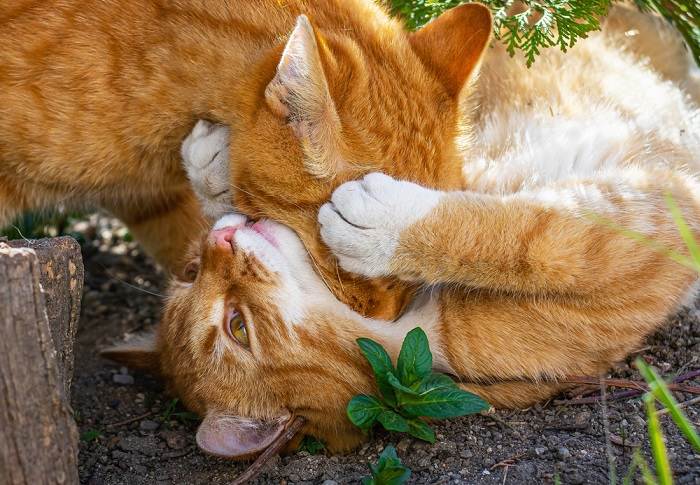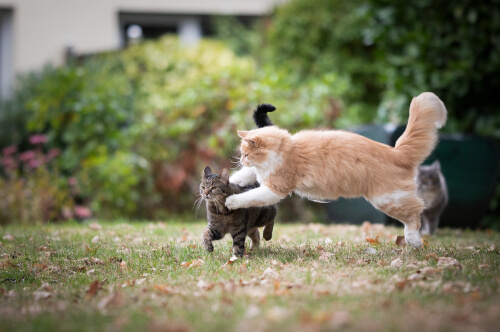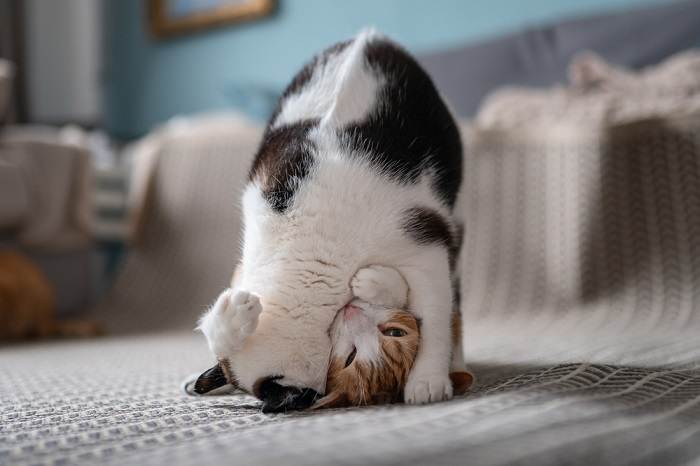
Have you ever found yourself wondering, “Why do cats bite each other’s necks?” After all, it seems like such a primal behavior, one that you would expect more from a wildcat. However, domestic cats are descendants of wildcats.
Perhaps when our cats are snoozing, snuggled up on our laps, it’s hard to imagine that they are descended from these wildcat ancestors. And yet, watch your pets a little closer, and you’ll see just how many wild traits they have adapted to express in their more domestic surroundings.
Neck biting is a common behavior that can manifest for several reasons. It can be alarming to watch, but this adapted behavior also has positive manifestations, too. After all, not all neck biting results in injury, and it is an essential part of feline communication. Here are the top five reasons why cats bite each other’s necks:
1. Mating Behavior
When cats mate, male cats often appear dominant over female cats. The tom cat mounts the female and bites her neck to hold her still. Generally, this will not harm the female, and protects the male when he is most vulnerable. Neck biting has a calming effect on the female (just as mothers lift or hold their kittens in their mouths) and prevents her from turning and attacking him.
In fact, carrying young is another instance where cat neck biting is not intended to cause harm. Cats are adept at carefully lifting their tiny kittens by the scruff of their neck, perhaps to move them out of harm’s way or to a new den or bed.
This is the safest and most effective way for the queen to carry her young. Remember, fur protects a kitten’s fragile skin from gentle biting. And holding them by the scruff of the neck is believed to have a calming effect on the young kitten.
Also Read: Cat In Heat: Signs, Symptoms & Care
2. Playing and Learning
Kittens love to play fight with the family, other cats, and toys. Playing is a fantastic opportunity for young cats to mimic and trial different behavior while allowing them to test boundaries and communicate with their peers and human family.
Kittens get the opportunity to hone their fighting and hunting skills, and have a lot of fun in the process. When cats bite each other’s necks, they are likely also pouncing and tumbling, which is exciting. Plus, the recipient of the neck bite provides instantaneous feedback on what is OK and what is not. This learning process is very fun for a cat.
But what about when you play calmly with your adult cat or sit grooming them, and they turn and bite? This is just their way of telling you they have had enough. Read more about why your cat might bite you when you are petting him.
Also Read: 8 Purrfect Games You Can Play With Your Cat
3. Fighting and Dominance

in multi-cat households, displays of dominance and neck biting can be a way for your cats to maintain their hierarchy.
A male cat has learned all he needs to know about fighting through play, but when he reaches sexual maturity, his view of the world is slightly different. After all, as his adult hormones kick in, he becomes more adventurous and starts to mark his territory. Still, not all of his neighbors may be as welcoming as he had hoped, and some aggressive cats may be on the block.
Suppose your cat’s territory overlaps with that of another cat. One cat will likely take issue with this. It is also common for cats to express dominance over resources. This includes space, food, litter boxes, toys, and human contact.
When male cats bite each other’s necks, it is an expression of their dominance over another cat vying for the same resource. This is common when cats are fighting outside the home. But also in multi-cat households, displays of dominance and neck biting are ways for cats to determine and maintain their hierarchy.
A new cat may take time to settle into an established hierarchy, and this integration should be managed carefully. Here are some tips on how to introduce your new family member successfully.
4. Hunting Instinct
You may witness your cat demonstrating a whole array of hunting skills, from silently stalking to pouncing and attacking their prey. The intense drive to do this can be overwhelming for them. As with their wild ancestors, cats are programmed to immobilize their prey as quickly as possible. Biting the neck of their target is highly effective. Your cat may not be out prowling every evening. Instead, you may see their predatory instinct driving play behaviors with their littermates or toys just the same.
5. Increased Aggression Due to a Medical Issue

Occasionally, neck biting of housemates and aggressive behavior might signal a behavioral or medical issue.
If your cat has always been a bit of a softie but is suddenly showing more aggressive behavior, they might be trying to tell you something. If biting other cats’ necks is completely out of character for your cat, try to determine whether your cat is under any undue stress.
Changes around the house, within the family, or in the neighborhood could be the underlying issue. If no extraneous cause can be identified, consider whether your cat feels unwell or is in pain. Behavioral changes and increased aggression in cats can result from many medical conditions.
For example, some medical conditions cause chronic pain (such as arthritis) or behavioral changes as a result of hormonal imbalances (such as hyperthyroidism) or neurological disease (conditions affecting the brain). Often these illnesses come with other symptoms, too, so monitor your cat carefully for any other out-of-character behaviors. If you think your cat’s behavior change might be due to illness, a trip to see your veterinarian is essential.
At the end of the day, neck biting is not a behavior that needs to be eliminated entirely. It is essential, however, to get to know your cat’s body language and intervene before things get out of control. Giving cats in multi-cat families plenty of space is also important. And, of course, if the worst of the fighting is happening with neighborhood cats at night, you may have to implement a curfew to keep your cat safe.
Also Read: Do Cats Get Annoyed? 10 Subtle Signs To Watch Out For







